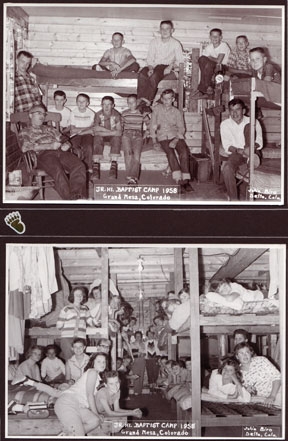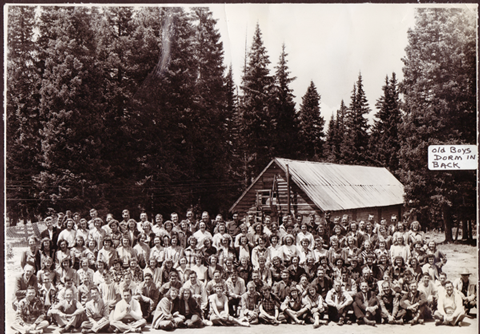How did a 28 acre jewel of a camp atop the Grand Mesa come to be?
 Here is the story – including how some things never change for campers!
Here is the story – including how some things never change for campers!
1917… A beginning
The Grand Mesa Youth Association campground on Baron Lake began in 1917 with a tent in the woods, erected by the Methodist Church. The first permanent building was a T-shaped log structure with a stone fireplace at one end. It served as a chapel, dining room and girls’ dormitory. The boys continued to tent for a few years. No kitchen existed in that building; cook stoves were set up outdoors. Dishes were washed by dunking them in wash tubs of boiling water heated on the stoves.
One winter the snow collapsed the roof of that building; so they started rebuilding with the Columbine chapel, which has since been remodeled into the recreation hall. Later a dining hall and a dorm were constructed. Drinking water was hauled in, and all other water was hand-pumped from the lake. Nothing but the cook stove was heated; thus kids were advised to bring huge bedrolls.
Boating, fishing, horseback riding, moonlight hikes and Craig Crest hikes were as popular then as now, and some of the questions the young folks were debating in the 1930’s were “What shall I do with my life? And what and why is the church?”
1923… Baptist joins Methodist
Camping for the young Baptists started in 1923 with the Western Colorado Baptist Assembly which first rallied at Eckert, then for a couple of years at Cedaredge, and after that they rented the Methodist camp on Grand Mesa which was called Mesa Epworth League Institute grounds.
By 1927, the Baptist Youth Camp had grown to include young people from all over Western Colorado. Records show costs of $1.00 for registration and 35 cents per meal. The cost of renting the campground for one week was $143.50. Baptists held a Golden Anniversary celebration in 1977 to celebrate 50 years of camping on Grand Mesa.
 1948 to now… Upgrades
1948 to now… Upgrades
As the camp enlarged and times modernized, the National Forest Service required the installation of sanitary facilities — a bath house with flush toilets and showers were built in 1948.
Low funds led the Methodist and Baptist Churches to become joint owners of the camp in the late 1940s. One of the agreements in the charter stated that contributions made by one denomination would be matched by the other.
Thus, when Mrs. Haldane of Grand Junction donated money to build the present Christ’s Chapel, the Baptist Church matched contributions by building McQuery Dining Hall. The girls’ dorm was remodeled into an administration and craft building – Barnett Craft Hall. Columbine Chapel was remodeled into Columbine Recreation Hall and one by one the old cabins (which had been sponsored by and named for individual churches) were replaced.
